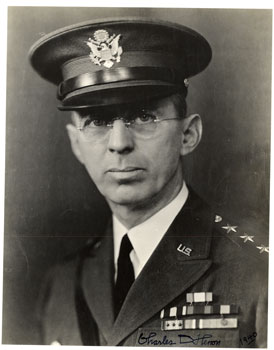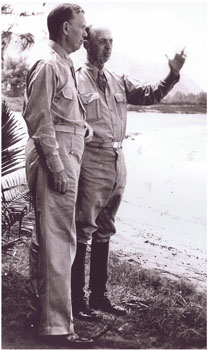"A Man of Character, Fearless and Dependable"
Could the recommendations of General Charles Herron, Class of 1897, have prevented the attack on Pearl Harbor?
 It happens in the oddest places! Last fall while cleaning my basement I was listening to a recording of a book about the attack on Pearl Harbor. All of a sudden the voice was talking about a General Herron.
It happens in the oddest places! Last fall while cleaning my basement I was listening to a recording of a book about the attack on Pearl Harbor. All of a sudden the voice was talking about a General Herron.
Now, I had encountered a General Herron in Dean George Kendall’s papers and I wondered, Was this “our” General Herron? Just the smallest bit of digging answered a resounding “yes.”
Charles, the oldest son of William P. Herron, was raised on the Wabash campus in the house now occupied by Dean Gary Phillips and his wife, Alice. After two years at Wabash, he applied and was accepted at the Military Academy at West Point. Herron’s class at West Point was graduated early due to a need for officers in the Philippines. It was later during this posting that Herron first met Douglas MacArthur, a new graduate just out of West Point—with “very top military and scholastic honors.” As Herron was the senior officer, he had a grass shack of his own and he offered to share it with this new, young officer. Herron later said of MacArthur, “He was strikingly handsome and when he turned on the charm, none could resist…He could talk the birds out of the trees.”
Following this posting in the Philippines, Herron was off to Fort Leavenworth for additional military education. The top man of Herron’s class was George Marshall—later described by Harry Truman as “the foremost living American.” Herron’s close acquaintance with Marshall—whose European work (the Marshall Plan) after WWII would garner him a Nobel Peace Prize—intensified as both men served on General Pershing’s staff in WWI and continued through the end of Herron’s career when he served on Marshall’s staff in Washington as a special personnel advisor.
Promoted to captain and transferred to the Panama Canal Zone in 1915, Herron was described by his commander there as “a man of character, fearless and dependable.”
In the 1930s Herron served in the War Department under MacArthur, who was the Army’s Chief of Staff. It was there that he met and came to know a young aide, Dwight D. Eisenhower. Herron described him as “tall, of powerful build, genial, cheerful, and of great personal charm. He was erudite, a rapid and vigorous reader, a gifted writer and a master of the arts of persuasion.”
But it was on his last active posting in the Army that the best part of this tale really begins. In 1937 Herron was charged to take command of the Hawaiian Division. This posting was to be his last, prior to retirement. Herron’s great challenge in this posting—the War Department’s growing distrust of the Japanese-American population in Hawaii—became his great legacy. As a part of his work in Hawaii, Herron often met with local farmers and plantation owners. It was through this part of his work that Herron came to know a great many Hawaiian Americans of Japanese ancestry. Herron felt that, contrary to widely held opinions, these folks were “loyal to the soil and not to the blood.” He advocated integration of Japanese American soldiers into units in the regular army—a position the army’s general staff did not support. Still, as a direct result of General Herron’s observations, efforts, and his Congres-sional testimony following Pearl Harbor, no mass internment of Japanese-Americans occurred in Hawaii.

In another extraordinary piece of foresightedness, Herron saw real weaknesses in the military defenses of Hawaii. A year before Pearl Harbor was attacked, he warned Army Chief of Staff and old friend George Marshall that enemy carriers would approach at night and launch planes for a predawn attack. He saw the potential for wide destruction of both naval and air forces, and he argued for a long-range reconnaissance patrol and an efficient early warning communications system.
Marshall agreed and some plans were put into place in Hawaii. Then in February of 1941—10 months to the date before the attack—Herron retired from the Army and returned to his home near Washington, DC. He left detailed instructions for his successor and clear paths to better protection for Hawaiian bases. It is one of the sad facts of history that his successor had little interest in Herron’s plans or worries; it is said that he didn’t bother with reading the summary Herron had prepared on conditions and concerns in the Hawaiian Division. Further reading on this topic confirms that Herron was right and much more should have been done by his replacement.
Could Herron have prevented the Pearl Harbor attack? Probably not, but the losses might have been substantially lower.
General Herron’s retirement was not to last. He was recalled to duty by General Marshall in September of that same year, assigned to the War Department’s General Staff, where he served for the duration of the war.
Herron retired again in 1946 to Bethesda, MD. But even in retirement, his old friend, President Dwight Eisenhower, called upon his services. When the President asked Herron to come to Washington to help him out, the general replied that he would, but “only if I can wear civvies.” The president replied, “Come in your pajamas if you want, but come!”
In 1966 Herron returned to live in Hawaii to be near his daughter. Years earlier, his affection for the islands prompted him to testify in favor of Hawaiian statehood before a House of Representatives committee. He died in Honolulu in 1997 at the age of 100.
Throughout his distinguished career, General Herron served his country and his College well and with honor. Among his many numerous medals is his Distinguished Service Medal with Oak Leaf Cluster for “exceptionally meritorious and distinguished service in a position of great responsibility as special assistant to the chief of staff, displaying original and clear thinking in the solution of difficult and serious personnel problems.”
Beth Swift is archivist for the Robert T. Ramsay Jr. Archival Center at Wabash.
Photo
Above: General Charles Herron with Army Chief of Staff George Marshall
 It happens in the oddest places! Last fall while cleaning my basement I was listening to a recording of a book about the attack on Pearl Harbor. All of a sudden the voice was talking about a General Herron.
It happens in the oddest places! Last fall while cleaning my basement I was listening to a recording of a book about the attack on Pearl Harbor. All of a sudden the voice was talking about a General Herron. 